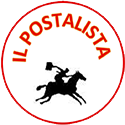translated into:
| pagina iniziale | le rubriche | storia postale | filatelia |
Slovenian Litoral and Istria in 1945.
Miroslav Oražem, 13.3.1900-23.7.1975, student, Pinter, graphic artist, sculptor, and architect: he graduated in 1927 from the Department of Architecture of TF (Technical Faculty) in Ljubljana by Jože Plečnik. While studying, he worked with a sculptor A. Arhipeng in Berlin, 1929-30, he met Le Corbusier in Paris. In the years 1934-50, he taught in the Ljubljana Technical School. He was drawn to avant-garde artistic tendencies, initially constructivism and cubism. To the public, he presented himself for the first time in 1924 at the Ljubljana Youth Club exhibition with the statue of "Torzo". He showed up again in 1953 at the exhibition of the Ljubljana Society of Decorative Arts with the already abstract garden plastic under the influence of H. Arp and H. Moor. He has also worked in architecture, interiors and applied arts. (From the encyclopedia of Slovenia, 1994)
Miroslav Oražem, designer of the first stamps of the Slovenian Littoral and Istria: The Slovenian Littoral and Istria experienced a real philatelic boom when for the first time they can read the Slovenian or Croatian words. The stamps with motifs of places and costumes with the bilingual inscription Istra / Slovensko Primorje - Istria / Slovenian Littoral arrived at the post offices on 15th August 1945. These were the "chainbreakers" of the Slovenian Litoral and Istria in 1945 by M. Oražem.
The stamps were printed in the Ljudska pravica printing office in Ljubljana. The designs were prepared by him, Miroslav Oražem. The following editions have been printed with modified colors and values in Zagreb and Belgrade. Subsequently, the Yugoslav stamps were used for the entire territory of Zone B of Julian Venetia with overprinting in three lines »Vojna uprava / Yugoslovenske / armije«, eng. "Military administration of the Yugoslav army". By September 15, 1947, 108 provisional, regular and revenues postage stamps were used. All values were in (jugo) lire.
 |
| Figure 1. Letter from 7th June 1945 of Postal administration in Ljubljana to Oražem. |
Since the letter dated 7 June 1945, the Ljubljana Postal Administration (Fig. 1) has informed the typography and the designer (M. Oražem) of the number of 5,000,000 stamps in (jugo) lire for the Slovenian litoral and Istria to be done. The typed text was repeatedly corrected by Oražem itself with the names of the stamps, the size and the quantity issued. The basic proposal covered 10 stamps. With the first correction of two added, and one canceled there were - 11 stamps in total. The issue was expected in the coming days.
As we know, the events in 1945 took place differently. The "victory" /zmaga stamp for 50 Lire, which we see in Fig. 2, was not issued. As there was no annexation planned for Trieste, therefore, the stamp on Fig. 3 of 1 Lira San Giusto / Sv. Just (Trieste), is today known only as "not issued" in brown and red, cut or perforated. The letter was sent before the Yugoslav army had to withdraw to the Morgan line on June 12, 1945.
 |
| Figure 2. Oražem original drawing »victory« of the 50 Lire stamp, not issued. |
 |
| Figure 3. Original drawing for the stamp for 1 Lira (San Giusto, Trieste), not issued. |
The total quantity of issued stamps does not give more than 5 million pieces, but less. Apparently, the author felt that these numbers were too high. If we look in the catalog (Tergeste, catalogo speciale, A. Bornstein, Trieste, 1949-50), we see that the total quantity of stamps is even lower. This is because a significant number of stamps were used to overprint with new face values, and with »PORTO« for the use as revenues postage stamps.
The first four stamps were issued after two months, i.e. 15.08.1945. We can see from Fig. 4 that the final set of 10 stamps is slightly different from the first version.
The story of two »tt« is also interesting. All stamps issued have the word "littoral" written with two »tt«. Apparently, the error was corrected only with the essays of San Giusto, Trieste for 1 Lira, where "litoral" is spelled correctly (Fig. 4).
Final set with the bilingual writing (It., Slo.o Cro.) we see on Fig. 4:
 |
| Figure 4. Final series designed by Oražem for the Slovenian coast and Istria, 1945. |
Miroslav Oražem, the legacy: it includes a folder of drawings with a series of sketches of all the stamps and some drawings of them. Especially those that have not been issued (1 Lira San Giusto, Trieste, 50 Lire "victory"). The author made more than 20 drawings, and 100 sketches.
On 13th July 2020 the Post of Slovenia will be issued a special commemorative stamp to celebrate 75. Years of the first Slovenian stamps for Slovene litoral and Istria.


